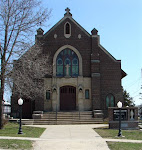Wednesday, November 16, 2011
Recommended Reading
Recommended by Fr. Pisut.
Recommended Reading
Though the New Theological Movement blog rarely enters into matters liturgical or rubrical, preferring to consider the more profound theological foundations, the re-introduction of the use of black vestments in parish life seems to us to be so important to the renewal of the faith of the people (at least in the USA, though most likely throughout the world) that we must devote a post to this cause.
In the Novus Ordo – that is, the ordinary form of the Roman Rite which is celebrated in most parishes in the USA (in English) – there is no reason why black may not be used regularly. In the usus antiquior – the extraordinary form – black vestments remain mandatory for certain Masses. Let us consider the theological points first, and then we will make a few practical conclusions.
The meaning of black vestments
Black is, of course, a symbol of death (that is, in Western Civilization). Certainly, other colors have also been used to represent death – even green! Still, for the most part, black is the traditional symbol of death in Western culture, and this still holds today. In the Western world, everybody wears black to a funeral … except the priest, and he often wears white!
Black does not signify despair, not at all. Rather, black is the symbol of mourning, of loss, of death – but this mourning will be turned to joy, the loss is great gain, and death is birth unto true life. The color black is in no way contrary to Christian hope.
Black as a liturgical color
It is worth noting that – although, in the early days of the Church, white seems to have been the color of vestments on every day of the year – black was almost certainly introduced into the liturgy before violet (purple). In fact, it seems that black came to be used as one of the (originally) four principal colors of the Mass: White, green, red, and black.
Considering the antiquity of the color, it is somewhat surprising that black is used far less often today than is violet – while many Catholics have seen violet used (in Advent and Lent), nearly an whole generation has never seen a black vestment (at least in the USA).
Traditionally, black is used at all Masses of the dead and funeral Masses, on All Soul’s Day, and on Good Friday. In the Novus Ordo, black is not to be used on Good Friday, but may still be used at the other Masses (though violet and even white are also permitted, and in practice preferred). There is no reason why a priest could not, in the Novus Ordobegin to use black vestments at least for All Soul’s day – and even for funerals andRequiem Masses.
The theology of a Requiem Mass for the dead
Black signifies mourning, but not simply mourning in general. Rather, black directs us in a particular way to mourn and pray for the dead. While white is a color of festivity and rejoicing, violet is the color which signifies penance and sorrow for sin.
However, violet directs us more to mourning for our own sins, and to performing penance for our own wretchedness. Black, on the other hand, helps to direct us to mourn not for ourselves but for the deceased. This is why black is so fitting for the funeral Mass (as well as Requiems and All Souls’): The color reminds us to pray for the dead.
The funeral Mass is not really about the family – though there are certainly many prayers for the consolation of those who mourn. Rather, the funeral Mass is primarily for him who has died: Nearly every prayer is for the forgiveness of his sin (i.e. of the temporal punishment of sin). Funerals are not primarily for the living, they are for the dead – whatever anyone (even if he be a priest) may tell you! This is why it makes no sense – theologically – to wear either white or even purple for a funeral Mass or Requiem.
A test case: All Saints’ and All Souls’
Consider, as a test case, the recent feasts of All Saints’ and All Souls’ days. In many (perhaps most) parishes throughout the USA, the faithful saw the priest wear the very same vestment for All Souls’ day as he did for All Saints’. What sort of theology does this communicate to the people?
On All Saints’, the priest is directed to wear white vestments because the saints are already in heaven and enjoy the vision of God. They are perfectly happy and have no need of our prayers. All Souls’, however, is the Mass offered for the holy souls in purgatory – it is offered as a prayer in their behalf, for the remission of the temporal punishment they bear for their sins.
Now, if the priest wears white vestments on All Souls’ day, can he be the least bit surprised that his faithful have ceased to believe in the reality of purgatory? If the priest wears the color of festivity, rather than the color of prayerful mourning, who will ever believe that there are any souls who suffer purgation after death?
Considering the essential difference in the character of the Masses of All Saints’ and All Souls’, it is a scandal (yes, a scandal) that white is the most common color de facto for All Soul’s day. However, sadly, the use of white is by no means a liturgical or rubrical violation.
For continued reading click here: The New Theological Movement



